How Long Does It Take to Learn Guitar? – A Newbie’s Guide

There is one instrument that most musicians love. It’s the guitar.
The versatility makes it a great instrument to learn as you can essentially play it with any other instrument. Many people dedicate their lives to mastering the instrument. They put in countless learning the literature and mastering the techniques simply for the joy of it. However, some also give up somewhere down the line after starting.
The learning process is very different for everyone. Dedicating some time every day can have you playing the guitar in a couple of years if you’re lucky.
Today let’s find out how to learn the guitar in the most efficient yet fun way. Back in the day, people did not have the internet making the process pretty difficult.
Let’s break down how long it takes to learn and how to speed up the process!
Key Takeaways: The Timeline For Learning Guitar
| First Timers and Beginners | 1-6 months |
| Intermediate | 1-2 years |
| Pro | 2-3 years |
| Advanced | 5-6 years |
| Guitar Hero | 10+ years |
How Long Does It Take To Learn The Guitar?
Not everyone learns guitar the same way. Your friend might have learned to play the guitar within a couple of years but it might not be the same for you. There are many factors to consider such as time, ability to understand, and so on. To be an expert guitarist, a rule of thumb is to play the guitar for a total of 10,000 hours.
According to research done by Malcolm Gladwell, if you practice for 4 hours a day, you can from from being a beginner to a Guitar God in just 6.8 years! Let’s look at what research shows in detail.
| Skill Level | Hands-On Time | What You Can Achieve |
| First Timers and Beginners | 1-6 months | Learn the basics like holding a guitar, open chords, and single-string plucking methods. Once you’re accustomed to that you can move on to playing 4 chords songs with simple hammer-ons and pull-offs |
| Intermediate | 1-2 years | In the first two years, you should be able to play somewhat complex that incorporate riffs, blues, and so on. You may still be rough around the edges but you can get by. Practice is key in the first two years. |
| Pro | 2-3 years | With a good understanding of the literature, you can start improvising on songs or attempt to write your own. |
| Advanced | 5-6 years | At this point, you should be able to identify notes just by ear, play complex songs, and even take a chance to monetize your passion. |
| Guitar Hero! | 10+ years | Now that you are all about guitars at this point, you can expand out of traditional guitars, check out other genres, maybe learn the bass, and expand on your expertise. |
What Are The Levels of Learning The Guitar?
From holding the guitar for the first time to shredding in front of thousands takes time to achieve. To simplify the learning process, let’s break it down into 7 simple steps.
Check Out Our Top 10 Guitar Riffs For Beginners
Uno: Nailing the Fundamentals
This is the foundational level where you get accustomed to a guitar.
- Holding the Guitar: First and foremost you need to know how to hold the guitar in hand. The correct posture can reduce arm strain and improve grip. Learn the ins and outs of a guitar and identify parts like the fretboard, bridge, and tuning pegs.
- Basic Techniques: Practice strumming patterns and picking individual strings to develop your hand-eye coordination.
- Tuning: Learning to tune the guitar comes next. Try to understand the pitch of each string with the help of a tuner.
- Dabble Into Literature: Reading music theory can help you better understand the guitar. You get to learn about notes, chord formations, and the concept of keys and intervals. Mastering this can make the next levels relatively easier.
- Getting Into Single Note Exercises: You need to use both your hands, right? How about some simple exercises for the coordination between your left and right hand? Single-note exercises can make huge changes.
Dos: Learning Chord Progressions
This level is about mastering basic chords and developing rhythm. Here you have to do the following.
- Open Chords: Memorize basic open major and minor chords like E, A, G, C, and D. These chords are what most songs are made from.
- Strengthen Your Strumming Pattern: Strumming with rhythm can initially be challenging. Use a metronome to count beats to help keep rhythm.
- Start playing songs: Once you have covered all the above, start playing along with some songs to practice transitions and timing. Some good beginner songs can be Wonderwall by Oasis, Hey, Soul Sister by Train, and Country Roads by John Denver.
Tres: Developing Technique
Develop more technical skills:
- Alternate Picking: Train your picking hand to alternate between downstrokes and upstrokes. This way you can play faster while maintaining rhythm.
- Scale: Learn the minor pentatonic scale, a versatile scale used in many genres, focusing on the first position to start building solos and improvisations.
- Get accustomed to the fretboard: Begin to memorize the notes on the fretboard, starting with the first five frets.
Cuatro: Level Up Playing Techniques
Start tackling more complex chords and begin improvisational playing:
- Barre Chords: Barre chords help you play chords in any key across the fretboard. Once you get a hold of it, you will be able to figure out any chords once you identify the root note.
- Improvise with backing tracks: Start improvising with the scales you know over simple backing tracks.
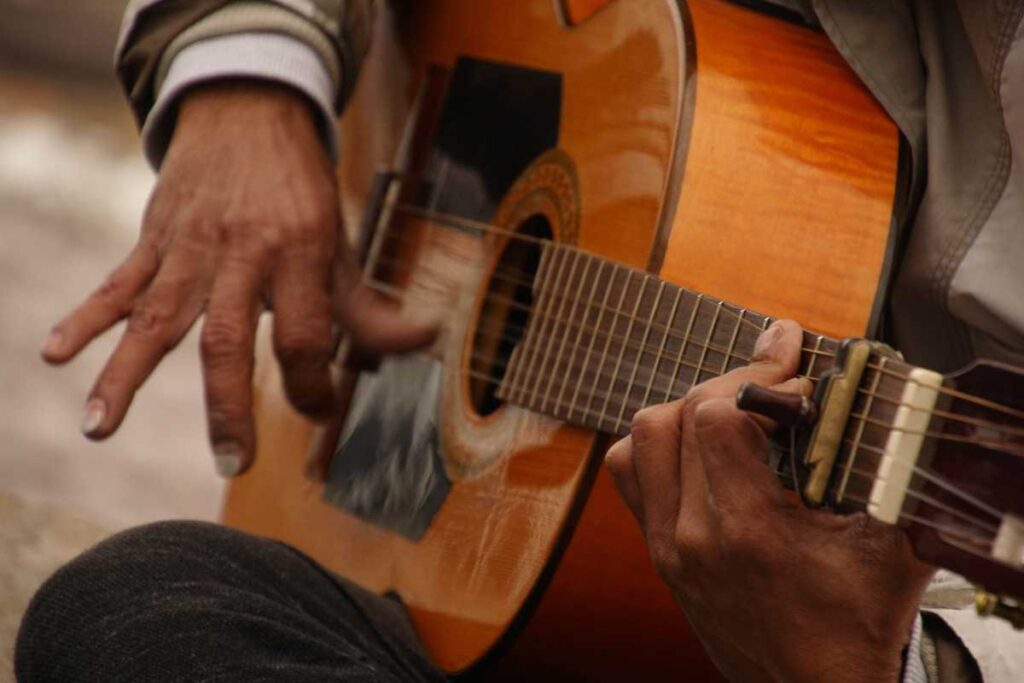
Cinco: Dig Deeper Into Advanced Techniques
At this advanced stage, focus on expanding technical skills:
- Master Pentatonic Scale: Master all positions of the pentatonic scale and learn major and minor diatonic scales.
- Seventh Chords and Extensions: Learn different types of seventh chords like major, minor, dominant, and half-diminished.
- Add Depth: Make your playing more expressive by using techniques like bends, vibrato, hammer-ons, pull-offs, and harmonics.
Ceis: Mastery of Styles and Complexity
Brush up all the above to add a professional touch:
- Modes and Modal Playing: Learn modes of the major scale to explore different tones.
- Advanced Arpeggios and Chord Voicings: Utilize the CAGED system to unlock different voicings across the fretboard and master arpeggios for solos.
For an even better picture, check out a video from this fellow guitarist and his insights on learning the guitar!
Follow These Tips to Speed Up The Learning Process
When learning how to play the guitar you can utilize an endless number of resources to speed up the process.
- Utilize Online Resources: There are many online resources you can utilize like YouTube and Songsterr. They have guitar tabs and playback features that you can use to practice and learn.
- Begin with Basics: As a beginner, you do not need the most expensive equipment. Save money on a budget acoustic guitar. Use free apps like Guitar Tuna or Pano Tuner instead or buy expensive tuners.
- Avoid Developing Bad Habits: Pay attention to the posture and techniques of experienced guitarists to avoid developing bad habits.
- Start with Any Song: There is no specific ‘right’ song or technique to begin with. The important thing is to start playing and working your way up.
- Respect the Schedule: Define a consistent practice schedule that fits your lifestyle, whether it’s a few hours a day or just a half-hour a week.
- Make the learning process fun: Focus on learning songs and riffs that you enjoy to avoid monotony.
You Can Start With These 4 Beginner Guitars
1. Zager ZAD50 “OM”
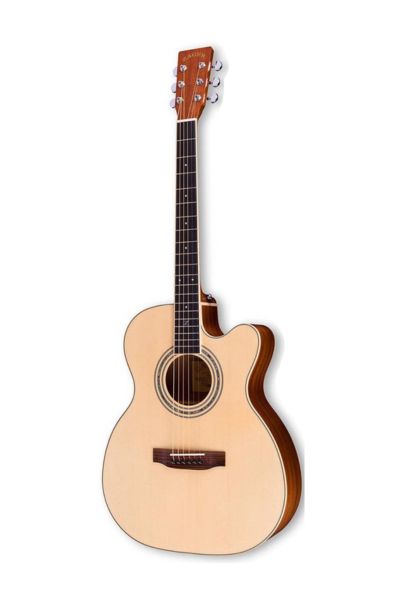
The Zager ZAD50 “OM” is a great beginner guitar to consider. It checks all the boxes on a premium guitar at a more affordable range.
It has a solid wood construction with a hand-carved bracing system that improves the overall rigidity. The guitar is not too big but the sound it produces comes close to bigger dreadnoughts. Additionally, the ZAD50 features custom string spacing and a soft touch fret design. This helps reduce sinter strain, especially useful for beginners.
The guitar comes with high-quality Grover tuning machines and an aesthetic hand-laid abalone inlay rosette finish. If you’re serious about learning the guitar, the Zager ZAD50 “OM” is an excellent choice for you. Not only that it is also a great investment that will last a lifetime!
Quick Spec List:
- Body: Solid wood construction
- Size: 15% smaller Orchestra Model.
- Neck: Adjustable truss rod with custom string spacing and soft touch fret design
- Hardware: Grover tuning machines, hand-carved bone nut and saddle
- Additional Features: Hand-laid abalone inlay rosette, hand-carved bracing system
2. Zager Travel
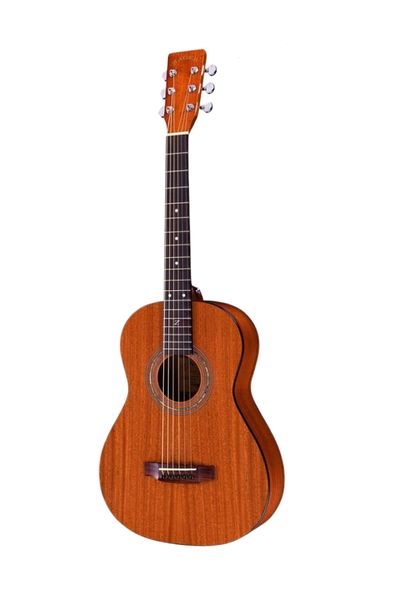
The Zager Travel Size is another great option for beginners. This guitar is smaller than the ZAD50 making it easier to maneuver if you have a small build.
It is constructed from premium materials such as solid mahogany. This gives the guitar a rich tone which improves with age. Additionally, you also get custom electronics and an automatic tuner adding to the list of features.
The onboard Fishman electronics have a slim neck and custom string that will make it easier to move across the fretboard. Overall the Zager Travel is a top choice for beginner guitarists looking for quality at a more affordable price.
Quick Spec List
- Body: Solid mahogany construction
- Neck: Slim neck design
- Fingerboard: Custom design
- Electronics: Fishman electronics with custom equalization
- Additional Features: Automatic tuner, custom string spacing, soft touch fret design
3. Yamaha FG800
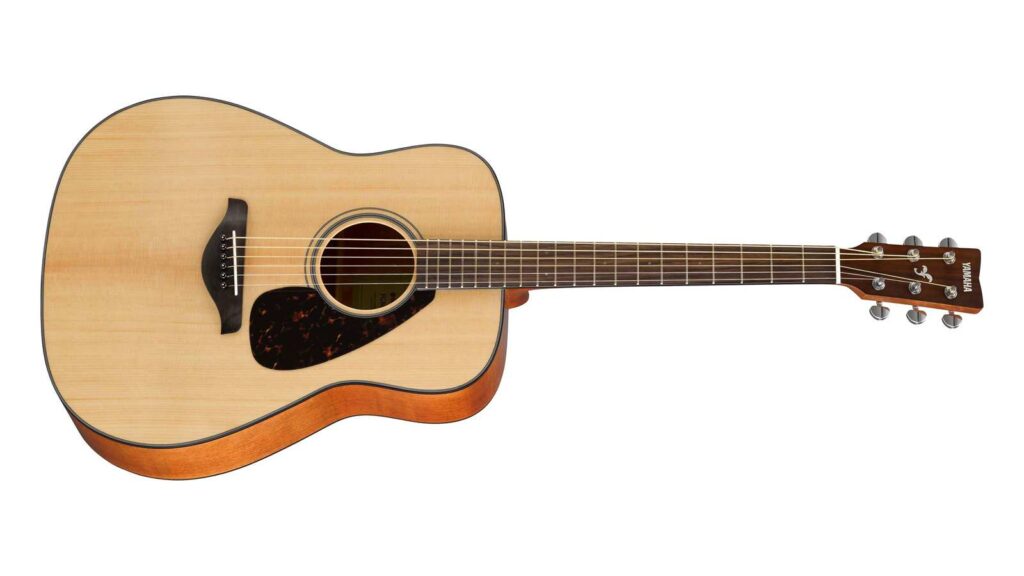
The Yamaha FG800 has a Sitka Spruce top with Nato/Okume back and sides. It is a dreadnought-style guitar with a rich, full sound.
With only 20 frets, the FG800 has a shorter neck than regular-sized guitars making it great for beginners. While the larger dreadnought body might be challenging for younger players, the FG800 sound makes up for the size.
Quick Spec List:
- Body: Sitka Spruce top with Nato/Okume back and sides
- Neck: Nato
- Fingerboard: Walnut
- Frets: 20
- Finish: Natural
4. Ibanez PC12MHCE
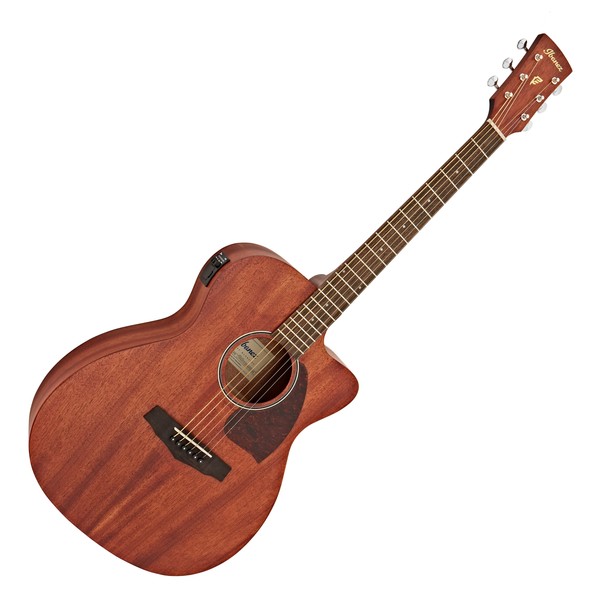
If you want a great acoustic electric guitar then the Ibanez PC12MHCE is another great option. It has an Okoume body and a sleek neck.
This guitar is compact making it great for guitarists who have small hands. Due to the size, the Ibanez does lack in the bass section. Despite that, the overall tone is something to praise! It has a cutaway design for easy access to the upper frets.
It has built-in electronics like an amplifier and a tuner making it a great starter guitar.
Quick Spec List:
- Body: Okoume top with Okoume back and sides
- Neck: Okoume
- Fingerboard: Laurel
- Frets: 20
- Finish: Open pore
Should I Start With An Acoustic Or Electric Guitar?
Ask any guitarist and they will say that an acoustic guitar should be your first guitar when you start learning. Nowadays, the choice between acoustic and electric guitars comes down to personal preference. Electric guitars can have some benefits for new players though.
Electric guitars have a thinner body thus they are closer to you when playing. The thinner necks make fretting chords easier, and lighter strings that are less demanding on your finger. However, a good electric guitar with reliable internals can be costlier than an acoustic one.
On the other hand, an acoustic guitar can also be beneficial, despite its challenges. Acoustic guitars typically require more hand strength due to thicker strings and wider necks. However, when you can master acoustic guitars, playing an electric should be a walk in the park. Adopting the ‘train hard, fight easy’ philosophy, when learning the guitar can give you a good base before
Check Out These Reddit Threads For Guitar Learning Processes
- How long does it take the average person to learn the guitar and play to an acceptable standard?
- [DISCUSSION] How long did it take you to get ‘good’ at guitar?
- [NEWBIE] How long did it take for you to start seeing results as a beginner?: r/Guitar
- [Newbie] How long does it take to learn guitar basics?
- How long did take you to learn?: r/guitarlessons
- Guitar players of Reddit; How long did it take for you to learn and what is the best way[s] to learn?: r/Music
Frequently Asked Questions
On average, you can start playing basic songs within a year of playing the guitar. However, some people can even play songs within a few weeks of starting lessons. It boils down to how passionate you are about learning to begin with.
Electric and acoustic guitars both have unique advantages. Electric guitars have thinner strings making them a great choice for beginners. However, when you have to play acoustic guitar you may face some difficulties, this is because acoustics require strength to properly fret. Thus it is best to start with an acoustic guitar.
Take Your Time With Learning Guitar!
Learning the guitar is no easy task if you are not dedicated. If you have a knack for the instrument, you should be able to master it in a very short time.
However, if you are struggling with it, you can make use of online resources like YouTube for insights and motivation! Taking personal guitar lessons can help out too but why pay someone for it when you can do it yourself for free?
